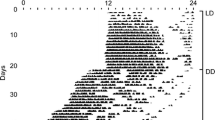Abstract
Spontaneous locomotor activity (LA) was recorded in five inbred strains of laboratory rats (ACI/Ztm, AS/Ztm, BH/Ztm, BS/Ztm, LEW/Ztm) under light-dark (LD 12∶12), continuous-dark (DD), and continuous-light (LL) conditions. Strain-dependent differences in LA were observed under each light condition. Under LD conditions, 24-h rhythms were found in the LA pattern of each strain studied. In addition, the BH strain showed a clear bimodal, and the LEW strain a trimodal, activity pattern. Spectral analysis of the activity patterns revealed distinct 4- and 4.8-h ultradian rhythms in the LEW strain and 12-, 6-, 4.8-, and 4-h rhythms in the BH strain. These strain-characteristic patterns persisted under continuous-dark conditions, therefore demonstrating their endogenous character. Under continuous-bright-light conditions the circadian rhythms decreased to a non-significant level in the AS and BS strains. This was not the case, however, in all animals of the LEW and BH strains. Despite the rapid decrease in the 24-h rhythm under LL, the LEW and BH strains showed significant ultradian rhythms.
Similar content being viewed by others
References
Aschoff, J. (1960). Exogenous and endogenous components in circadian rhythms.Cold Spring Harbor Symp. Quant. Biol. 25:11–28.
Aschoff, J. (1979). Circadian rhythms: Influences of internal and external factors on the period measured in constant conditions.Z. Tierpsychol. 49:225–249.
Aschoff, J., and Wever, R. (1962). Aktivitätsmenge und α: ϱ Verhältnis als Meßgröße der Tagesperiodik.Z. vergl. Physiol. 46:88–101.
Büttner, D., and Plonait, H. (1980). Langfristige Messungen der maximalen, mittleren und Ruheherzfrequenz an Laborratten mittels implantierbarer Telemetriesender.Zentral. Veterinärmed. A27:269–278.
Büttner, D., and Wollnik, F. (1982). Spontaneous short-term fluctuations in the daily pattern of heart rate, body temperature and locomotor activity in the laboratory rat.Lab. Anim. 16:319–326.
Daan, S. (1981). Adaptive daily strategies in behavior. In Aschoff, J. (ed.),Handbook of Behavioral Neurobiology, Vol. 4, Biological Rhythms, pp. 275–298.
Gibbs, F. P. (1979). Fixed interval feeding does not entrain the circadian pacemaker in blind rats.Am. J. Physiol. 236:R249-R253.
GV-Solas (1977). Liste von Erregern zur Spezifizierung bei SPF-Versuchstieren. Veröffentlichungen der Gesellschaft für Versuchstierkunde Nr. 2.
Feldman, J. F., and Hoyle, M. N. (1973). Isolation of circadian clock mutants of neurospora crassa.Genetics 75:605–613.
Halberg, F., and Panofsky, H. (1961). I. Thermo-variance spectra; Method and clinical illustrations.Exp. Med. Surg. 19:285–309.
Honma, K., and Hiroschige, T. (1978a). Simultaneous determination of circadian rhythms of locomotor activity and body temperature in the rat.Jap. J. Physiol. 28:159–169.
Honma, K., and Hiroshige, T. (1978b). Internal synchronization among several circadian rhythms in rats under constant light.Am. J. Physiol. 235(5):R243-R249.
Honma, K., and Hiroshige, T. (1978c). Endogenous ultradian rhythms in rats exposed to prolonged continuous light.Am. J. Physiol. 235(5):R250-R256.
Konopka, R. J., and Benzer, S. (1971). Clock mutants of drosophila melanogaster.Proc. Natl. Acad. Sci. USA 68:2112–2116.
Lemmer, B. G., Caspari-Irving, G., and Weimer, R. (1981). Strain-dependency in motor activity and in concentration and turnover of catecholamines in synchronized rats.Pharmacol. Biochem. Behav. 15:173–178.
Panofsky, H., and Halberg, F. (1961). II. Thermo-variance spectra; Simplified computational example and other methodology.Exp. Med. Surg. 19:323–338.
Peleg, L., Nesbitt, M. N., and Ashkenazi, I. E. (1982). A strain difference in the daily rhythm of glyceraldehyde-3-phosphate dehydrogenase activity in the mouse.J. Comp. Physiol. 148:137–142.
Plonait, H., Büttner, D., and Müschen, U. (1982). Ein kapazitiv arbeitendes System zur Messung der Bewegungsaktivität kleiner Labortiere.Z. Versuchstierkunde 24:244–249.
Possidente, B., and Hegman, J. P. (1980). Circadian rhythms under common gene control.J. Comp. Physiol. 139:121–125.
Sokolove, P. G., and Bushell, W. N. (1978). The chi-square periodogram: Its utility for analysis of circadian rhythms.J. Theor. Biol. 72:131–160.
Stephan, F. K. (1983). Circadian rhythms in the rat: constant darkness, entrainment to T cycles and to skeleton photoperiods.Physiol. Behav. 30:451–462.
Summer, T. L., and McCormack, C. E. (1982). Phase-response-curve (PRC) of circadian locomotor activity of the rat.Fed. Proc. 41:1698.
Szafarcyk, A., Ixart, G., Alonso, G., Malaval, F., Nouguier-Soule, J., and Assenmacher, I. (1981). Neural control of circadian rhythms in plasma ACTH, plasma corticosterone and motor activity.J. Physiol. (Paris) 77:969–976.
Terman, J. S., and Terman, M. (1980). Effects of illumination level on the rat's rhythmicity of brain self-stimulation behavior.Behav. Brain. Res. 1:507–519.
Wever, R. A. (1980). Circadian rhythms of finches under bright light: Is self-sustainment a precondition for circadian rhythmicity?J. Comp. Pysiol. 139:49–58.
Author information
Authors and Affiliations
Additional information
This work was supported by a grant from Deutsche Forschungsgemeinschaft (SFB 146).
Rights and permissions
About this article
Cite this article
Büttner, D., Wollnik, F. Strain-differentiated circadian and ultradian rhythms in locomotor activity of the laboratory rat. Behav Genet 14, 137–152 (1984). https://doi.org/10.1007/BF01076410
Received:
Accepted:
Issue Date:
DOI: https://doi.org/10.1007/BF01076410




